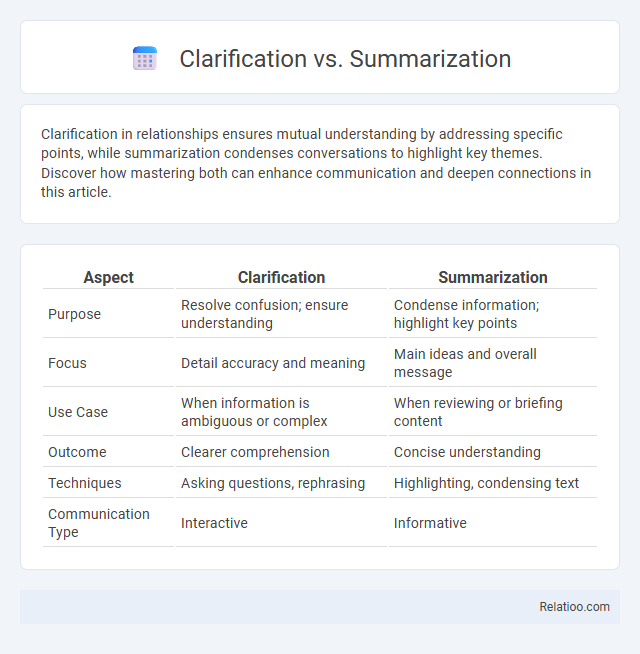Clarification in relationships ensures mutual understanding by addressing specific points, while summarization condenses conversations to highlight key themes. Discover how mastering both can enhance communication and deepen connections in this article.
Table of Comparison
| Aspect | Clarification | Summarization |
|---|---|---|
| Purpose | Resolve confusion; ensure understanding | Condense information; highlight key points |
| Focus | Detail accuracy and meaning | Main ideas and overall message |
| Use Case | When information is ambiguous or complex | When reviewing or briefing content |
| Outcome | Clearer comprehension | Concise understanding |
| Techniques | Asking questions, rephrasing | Highlighting, condensing text |
| Communication Type | Interactive | Informative |
Understanding Clarification and Summarization
Understanding clarification involves seeking additional information to resolve confusion or ambiguity, enhancing comprehension in communication. Summarization condenses key points or main ideas of content into a concise form, facilitating quick understanding and retention. Both techniques improve effective communication but serve different purposes: clarification addresses gaps in knowledge, while summarization distills information for clarity.
Key Differences Between Clarification and Summarization
Clarification involves making information more understandable by explaining or elaborating on details, whereas summarization condenses content to highlight the main points or essence. Clarification targets improving comprehension and resolving ambiguities, while summarization emphasizes brevity and core message extraction. Both techniques enhance communication but serve distinct purposes in information processing and knowledge sharing.
Importance of Clarification in Communication
Clarification plays a crucial role in communication by ensuring that messages are accurately understood, reducing misunderstandings and errors. While summarization condenses information to capture key points, and paraphrasing restates content in different words, clarification actively seeks to resolve ambiguity and confirm comprehension. Its importance lies in fostering clear dialogue, enhancing collaboration, and building trust between communicators.
The Role of Summarization in Information Processing
Summarization plays a critical role in information processing by condensing large volumes of data into concise, essential points, allowing You to quickly grasp the core message without sifting through excessive details. Unlike clarification, which aims to make ambiguous content understandable, summarization distills information to its most relevant elements, enhancing comprehension and decision-making efficiency. This streamlined approach supports better memory retention and faster information retrieval, crucial for effective knowledge management.
Techniques for Effective Clarification
Effective clarification techniques involve actively listening to ensure understanding, asking open-ended questions to gather more detailed information, and paraphrasing or restating what the other person has said to confirm accuracy. Your ability to provide clear explanations and examples helps eliminate confusion and reinforces comprehension. These methods improve communication by fostering a precise and shared understanding between all parties involved.
Strategies for Accurate Summarization
Effective summarization employs strategies such as identifying key ideas, eliminating redundant information, and condensing complex details while preserving the original intent. Techniques include focusing on main points, using paraphrasing to maintain meaning, and differentiating between essential and peripheral information. Clarification enhances comprehension by resolving ambiguities, whereas summarization distills content into concise, accurate representations.
Common Scenarios Requiring Clarification
Common scenarios requiring clarification include ambiguous instructions in the workplace, complex customer service interactions, and unclear technical documentation. Clarification ensures accurate understanding by asking targeted questions or requesting examples, which prevents costly errors and miscommunication. In contrast, summarization condenses information for easier comprehension, while restatement involves rephrasing content to confirm meaning without adding new details.
When to Use Summarization vs Clarification
Summarization condenses information by highlighting key points, making it ideal when You need a quick overview or to grasp the main ideas from a large amount of content. Clarification is used to explain, elaborate, or resolve confusion on specific details, ensuring accurate understanding during complex or ambiguous discussions. Use summarization to streamline information flow and clarification to deepen comprehension or address uncertainties.
Challenges and Pitfalls of Each Approach
Clarification often faces challenges such as misinterpretation and information overload, making it difficult for you to obtain precise answers. Summarization risks omitting critical details or context, potentially leading to incomplete understanding or biased conclusions. Paraphrasing can introduce errors or change meaning, which may confuse the original intent and reduce the accuracy of communication.
Enhancing Communication Skills with Clarification and Summarization
Clarification and summarization are essential techniques for enhancing communication skills by ensuring accurate understanding and retention of information. Clarification involves asking questions or restating information to eliminate ambiguity, while summarization condenses the main points into a concise overview, reinforcing key messages. Mastering both techniques improves interactions in various settings, such as business, education, and interpersonal communication, by promoting clear, concise, and effective exchange of ideas.

Infographic: Clarification vs Summarization
 relatioo.com
relatioo.com